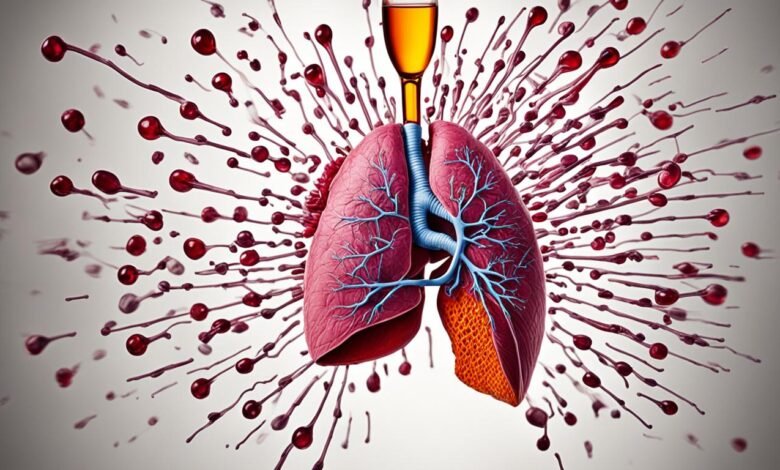
Welcome to our guide on alcohol-related liver diseases. We’ll show you how your liver gets affected by alcohol and the different liver diseases. You’ll learn how to prevent these diseases and why it’s crucial to know the risks.
Alcohol-related liver disease happens when you drink a lot of alcohol for a long time. This can really harm your liver. You can avoid it, but it can cause big health problems. There are three main types: a fatty liver, acute hepatitis, and cirrhosis.
A fatty liver happens with too much fat in your liver cells, making your liver get big. Acute hepatitis is when your liver gets hurt because of alcohol. It can kill liver cells and leave scars. Cirrhosis is the worst. It turns normal liver parts into scars.
This liver disease can get worse if you keep drinking too much. Some people might be more at risk because of their genes. But the good news is, you can stop it from happening. Just don’t drink too much.
Stick with us to learn more. We’ll talk about how to know if you have it, treat it, and stop it from getting worse. Also, we’ll look at how drinking too much alcohol leads to liver disease. Plus, we’ll share tips on how to keep your liver healthy.
Symptoms and Diagnosis of Alcohol-Associated Liver Disease
The signs of alcohol-associated liver disease can change based on the kind and how serious it is. Steatotic (fatty) liver might not show any symptoms at first.
As fat builds up in the liver, people could feel pain in their upper belly, be very tired, feel weak, and lose weight.
Both acute hepatitis and cirrhosis have similar signs. These include feeling feverish, weak, and having pain in the stomach or belly. They might also feel nauseous, vomit, and lose appetite.
Other signs can be poor diet, losing weight, and having yellow skin or eyes. They might also face problems like swelling in the abdomen, blood clotting issues, and confusion.
Remember, these signs can be linked to many other health problems. It’s wise to see a doctor for a proper checkup. Doctors usually use a person’s history, a physical checkup, and certain blood tests to check the liver. A liver biopsy (taking a small piece of liver for testing) and imaging tests like ultrasound or CT scans are also common. These tests help find out what type of liver illness someone has and how bad it is.
Treatment of Alcohol-Associated Liver Disease
The main aim in treating alcohol-associated liver disease is to get the liver working better again. The key first step is to stop drinking. This can be through a program or counseling to help quit alcohol for good.
Changing what you eat might also help your liver. Adding vitamins like B-complex and folic acid can fight malnutrition from the disease.
Doctors might recommend different treatments, depending on how bad the liver disease is. For example, changing your diet to include less salt can make your liver healthier. This is especially true for dealing with swelling caused by fluid buildup.
- Dietary changes: Eating balanced, low-salt meals can promote liver health.
- Salt restriction: Eating less salt helps reduce fluid build-up in your body.
- Procedures to shrink swollen veins in the digestive tract: These can lower the risk of bleeding from cirrhosis.
- Diuretics (water pills): Medications that can help your body get rid of extra fluid.
- Medications to treat confusion and inflammation: They help with brain fog and reduce liver swelling.
If the liver damage is really serious, a liver transplant might be an option.
The best chance for getting better involves quitting alcohol completely and following a treatment plan. This plan includes changing your life habits, what you eat, and possibly some medical help. Doing so can boost your liver’s health and your overall well-being.
Treatment Methods and Their Benefits
| Treatment Method | Benefits |
|---|---|
| Complete alcohol avoidance | Restores liver function and prevents further damage |
| Dietary changes | Improves liver health and reverses malnourishment |
| Salt restriction | Manages fluid buildup in the body |
| Procedures to shrink swollen veins | Alleviates bleeding and complications associated with cirrhosis |
| Diuretics | Manages fluid buildup in the body |
| Medications | Treats confusion, inflammation, and other symptoms |
| Liver transplantation | Replaces damaged liver tissue and restores liver function |
Complications and Risk Factors of Alcohol-Associated Liver Disease
Alcohol-linked liver disease comes with many problems that can really hurt a person’s health. If someone drinks heavily for a long time, they may have a bigger chance of getting diseases like hepatitis C and B. This makes the liver disease worse.
People with alcohol-related liver issues can face many more problems. These can include kidney trouble, bleeding in the stomach, swelling in the belly, feeling confused, or getting serious infections. They might also be at risk for liver cancer.
There are several things that can increase the chance of alcohol-related liver disease. Drinking a lot over a long period is a big one. While it’s more common in men, women can also get liver diseases from drinking less.
Family history can also make someone more likely to suffer liver damage from alcohol. This means your genes can play a role.
Differences in how common fatty liver is have been noted among different ethnicities. For instance, Caucasians and Hispanics are more likely to have it than African Americans or Asians. This shows the importance of both family history and ethnicity in liver disease caused by alcohol.
It’s really critical for heavy drinkers to understand these risks and problems. They should try to cut down on alcohol and get help from a doctor. This can help lower the chances of bad outcomes from alcohol-related liver disease.
Alcohol Consumption and Liver Disease: Epidemiological Evidence
Studies show that alcohol use is closely tied to many liver issues. One of the biggest risks is liver cirrhosis from drinking too much. The chance of getting liver disease goes up the more you drink. This shows a clear link between how much someone drinks and the risk to their liver.
The type of alcohol people drink might make a difference. Some research finds that drinking wine could lower the risk of liver cirrhosis. But remember, drinking too much is bad for your liver, no matter the type of alcohol.
While alcohol is a big risk, there are other things to think about too. How long someone has been drinking and their overall health matter. Also, genetics and how their body works can impact how they handle alcohol.

Knowing the dangers of drinking can help people make smarter choices. It’s better to drink moderately or stop drinking completely. This will lower the risk of liver disease and keep your liver healthier.
| Risk Factors | Protective Effects |
|---|---|
|
|
Lifestyle Changes and Prevention Strategies for Liver Health
Making certain lifestyle changes helps a lot to keep your liver healthy. This is especially important for avoiding liver disease linked to alcohol.
The big change you should make is to cut back or stop drinking alcohol. It’s key to drink in moderation if you do, following health guidelines. This step lowers your chance of getting an alcohol-related liver problem.
Eating healthy is also crucial for your liver. Pick foods that are low in salt and nutrient-rich. This means lots of fruits, veggies, whole grains, lean meats, and good fats in your diet. These foods do wonders for your liver.
Don’t forget about exercise. Being active helps keep your body weight in check and your liver in good shape. Try to do at least 150 minutes of moderate exercise or 75 minutes of intense exercise every week. Include some strength training, too.
It’s vital to see your doctor for regular check-ups. These check-ups help spot any liver issues early. This is important for getting fast treatment and keeping your liver healthy.
Getting the hepatitis A and B vaccines is a smart move. These shots protect your liver from harmful viruses. They are an important step in keeping your liver well.
“Prevention is better than cure.” – Desiderius Erasmus
By making these changes and taking preventive steps, you can cut your risk of liver disease. This way, you keep your liver healthy.

Key Points:
- Moderate or avoid alcohol to cut liver disease risk.
- Choose a diet low in salt to help your liver.
- Stay active with exercise to protect your liver.
- Get regular check-ups to watch your liver health.
- Get the hepatitis A and B vaccines to safeguard your liver.
Conclusion
Alcohol-associated liver disease is both common and something we can avoid. It’s directly linked to how much and for how long we drink. The disease moves through several stages, such as a fatty liver and acute hepatitis, eventually leading to cirrhosis. But, there is hope for recovery.
Staying away from alcohol and changing our way of life can do a lot to help our liver. This includes getting medical help for drinking too much and changing our habits. Eating well, staying active, and getting the right shots can lower the risk of this liver disease.
Doing these things can really lessen the chance of us getting this disease and keep our liver healthy. It’s crucial to look after our health by making smart decisions, getting help when we need it, and living a better life. This not only protects our liver but also improves our life in many ways.


